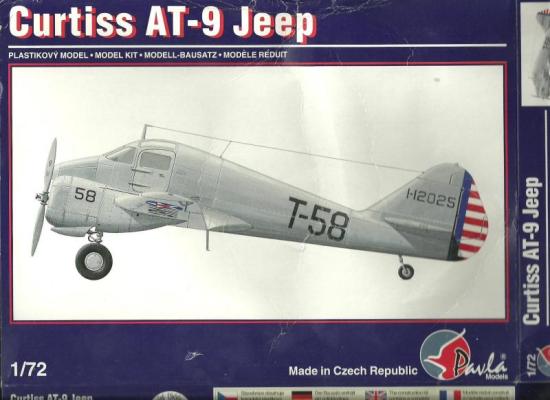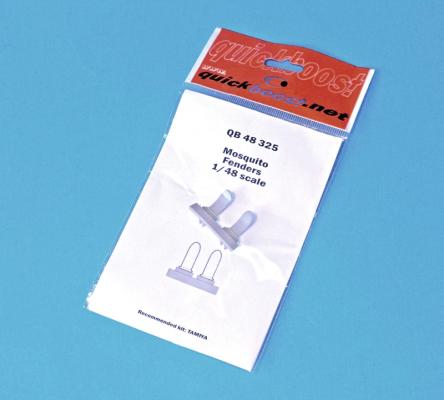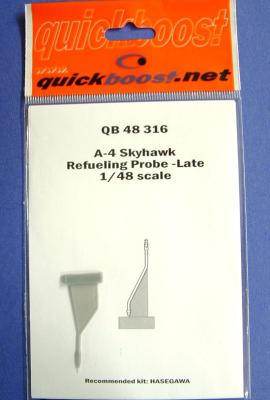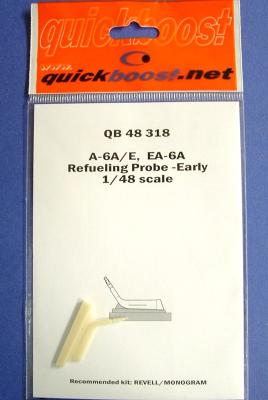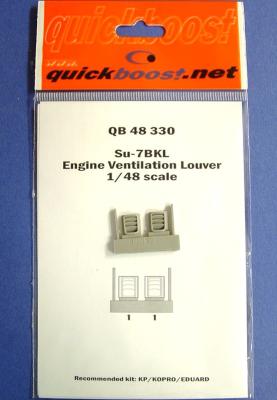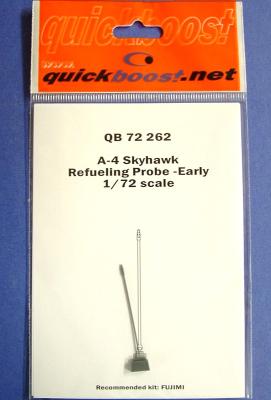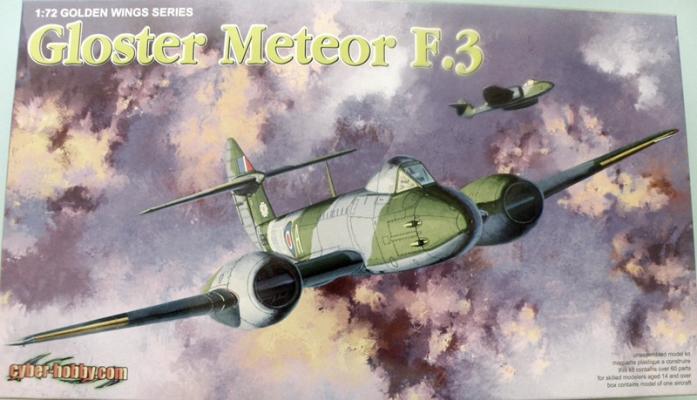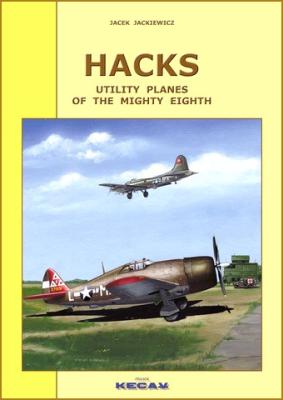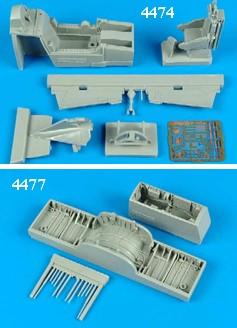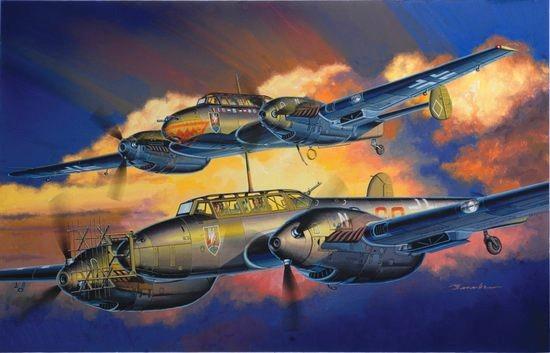The Curtiss-Wright AT-9 Jeep was a twin engine advanced trainer aircraft used by the United States during World War II to bridge the gap between single engine trainers and twin engine combat aircraft. The AT-9 was a low wing cantilever monoplane configuration with retractable landing gear and two Lycoming R-680-8 radial engines.
The folks at Quickboost now offer builders a set of cast resin fenders to enhance the landing gear details of any 1/48 Tamiya B IV or FB IV Mosquito kit. The fenders are cast in the same grey resin used for all other Quickboost aftermarket parts and come on a single casting block. Also typical of other Quickboost resin detail parts, they are crisply molded with no flash to remove and are free of pinholes. They offer better detail than the kit parts (the photo below shows the Quickboost part on the left and the kit part on the right).
They are easy to install. After removing them from the casting block and dressing up the edge with a couple of swipes with a sanding stick, they literally drop in place with no modification required. Because they are resin, they must be attached to the kit parts with super glue.
This set is recommended. My thanks to Quickboost and IPMS/USA for the review sample.
Quickboost continues to deliver targeted resin details; designed to improve overlooked aspects of a model, for a wide range of subjects.
This is a one piece set which provides a replacement for the later, bent refueling probe on the A-4. This part provides a clean one-piece replacement for the part on the Hasegawa A-4 without the worry of misshaping the probe or the shaft while removing the mold lines and injection pins. Plus this resin is a bit more durable than styrene and therefore subject to less breakage. The detail of the probe is better than that of the kit. If you have the perfectly fine Classic Airframes TA-4J, the kit lacks the later refueling probe, so this part makes it so you do not have to rob your Hasegawa kit. Recommended
We thank Aires Hobby Models and Quickboost for the review sample.
Quickboost continues to deliver targeted resin details; designed to improve overlooked aspects of a model, for a wide range of subjects.
Revell in their line of A-6 and EA-6 kits provides only a late style probe – this one piece replacement part provides the more correct early style. The detail is crisp and the probe well shaped; the modeler only needs to remove the resin pour piece at the tip. Recommended.
We thank Aires Hobby Models and Quickboost for the review sample.
Quickboost continues to deliver targeted resin details; designed to improve overlooked aspects of a model, for a wide range of subjects.
Quickboost continues to deliver targeted resin details; designed to improve overlooked aspects of a model, for a wide range of subjects.
This is a one piece set which provides a replacement for a straight refueling probe on the Fujimi A-4. It provides a clean one-piece replacement for the A-4 without the worry of misshaping the probe or the shaft while removing the mold line. Plus this resin is a bit more durable than styrene and therefore subject to less breakage. The detail of the probe is amazing. Recommended.
We thank Aires Hobby Models and Quickboost for the review sample.
To my knowledge there were very few 1/72 scale Gloster Meteors produced so it came as a very welcome offering by Dragon.
Upon opening the box, I was impressed with the molding of this kit. The details were very fine and crisp. I consulted my research books and decided to use a white scheme, which was only used on 3 F.3 aircraft.
Assembly was pretty straight forward. The cockpit was very complete; was painted in black and was not very difficult to do. The landing gear assembly in Step 1 was a little confusing when gluing parts B-3 and B-2. I knew that the Meteor was somewhat tail- heavy so I added a load of fishing sinker shot. I don’t know how much weight I added but next time I build a Meteor, I am going to add a brick as mine still became a tail sitter.
The fit on the wing assembly was very good with only a little filler needed at the upper wing root. After the wings were fitted the flaps, landing gear and landing gear doors were added.
Mention “hack” in today’s society and most people think of something to do with computers. Mention the same word to aircraft modelers and we think of utility aircraft such as Norsemans, Bobcats, Piper Cubs, etc.
”Hacks” is the story of those aircraft used by the Bases and Groups of the Eight Air Force in England during WWII. The book has a soft cover with the complete text in English and consists of 132 pages, 267 photos and 195 color profiles. Besides the more common utility type of aircraft, hacks included War Weary Thunderbolts and Mustangs, Bostons and Forts and many other types. These are details with at least one picture, a profile and a little bit of data.
The book starts out with a numerical listing of the USAAF stations in the United Kingdom between 1942 and 1945. There are 360 bases listed.
Continuing the build of F-102’s: Having just built the Encore F-102A, I had offered my services to build one of my stash Revell/Monogram F-102A kits around these Aires items. They are simple upgrades, with major appearance improvements. Aires continues to set an almost unbeatable standard for detail. Their fit has improved greatly over the years, and once complete, you have a work of art at reasonable cost.
First, the wheel wells. The main gear well requires you to remove part of the existing interior hump from the upper wing surface, locating pins for the kit wheel well bulkheads, and sand down the back of the beautifully-done one-piece main wheel well supplied by Aires. This done, the well slipped into place and was glued down without problems. The wing halves were then glued together. An excellent fit on all accounts.
Part 1. First Look
Before I get onto reviewing this model, I would like to give a little background information about this aircraft.
The Messerschmitt Bf110 served in the Luftwaffe throughout WWII. Even though it wasn’t very popular with the German pilots at that time it was developed into a successful night fighter, in spite of its poor handling characteristics. Later on it was found that it would make a great night-fighter and then became the backbone of the German Luftwaffe night fighter wing of WWII. Some of these units were formed as early as 1940.
In August/September 1943, Bf110 aircraft shot down over 2700 RAF bombers. Also, in just one night without fighter cover, these aircraft destroyed at least 120 RAF bombers. The Bf110D was a long-range heavy fighter and/or fighter-bomber, while the improved and up-armored Bf110E was designed primarily as a fighter-bomber.

